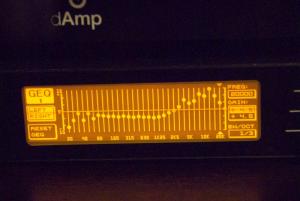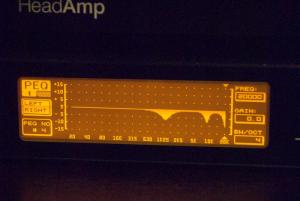-
Posts
8,819 -
Joined
-
Last visited
-
Days Won
32
Content Type
Profiles
Forums
Events
Everything posted by Dreadhead
-

Some Test Results (SE vs Balanced vs Portable SE)
Dreadhead replied to Dreadhead's topic in Headphone Amplification
You know what I think you're right Sorry about that! I had been convinced (by myself) of what you were saying and then convinced the other way (again by myself) but with your mental picture I think you've settled it in my head Sorry again that was dumb of me :palm:. I still think it's a measurement artifact though since the difference is on the order of the 6dB that occurs when you go from balanced to SE. That and when I did the tests it didn't show up. The floor was actually a little higher for balanced because each amp was working at a lower gain and hence the noise floor of the amp was at a higher level. -

Some Test Results (SE vs Balanced vs Portable SE)
Dreadhead replied to Dreadhead's topic in Headphone Amplification
Balanced reduces noise by common mode rejection but to do that you have to convert the signal back to SE which we don't do in most balanced SS headphone designs. -

Some Test Results (SE vs Balanced vs Portable SE)
Dreadhead replied to Dreadhead's topic in Headphone Amplification
That's why I made a point of using an adapter to go SE. Moving the heaphones can change the curves A LOT (not just the isolation). That's what I was saying. As far as the noise floor goes, that's the noise floor of the measurement not of the phones. The phones are being forced with a sinusoid and will put out at that frequency and harmonics of of the frequency but not a wide banded noise like that. The fact that the noise floor changes almost certainly points to the measurement being carried out at a different volume or the SE amp has severe wide banded hiss problems. In my setup the noise floor was identical between SE and balanced when the signal amplitude was the same. -

Some Test Results (SE vs Balanced vs Portable SE)
Dreadhead replied to Dreadhead's topic in Headphone Amplification
Well looking through the headroom results it's interesting to see that the physical properties of the headphones are changed as well. The isolation changes with balancing: As does the noise floor of the measurement: Extremely interesting. -

Some Test Results (SE vs Balanced vs Portable SE)
Dreadhead replied to Dreadhead's topic in Headphone Amplification
Well Headroom is redoing their headphone response curves: Products - HeadRoom - Right Between Your Ears And they have some balanced ones: =263&graphID[]=303]http://graphs.headphone.com/graphCompare.php?graphType=0&graphID[]=263&graphID[]=303 =283&graphID[]=313]http://graphs.headphone.com/graphCompare.php?graphType=0&graphID[]=283&graphID[]=313 It looks like they find a lot more difference between the two that I do. Interesting. We'll see what comes out with the 650s. One thing to note is their measurements are at the ear-drum mine are just using a coupler and are supposed to represent at the entrance to the ear. -
The Ety ER4 are also firmly in that boat. The AE-2 takes them on with ease too.
-
Turns out you can bypass the tube For me again... TPA Buffalo looks awesome too. What's the wait time on boards?
-
any idea of cost? edit: ooops missed it on the first page Not for me though
-
I can't solder worth a crap and I don't have time to do the build justice anyway even if I could. I'll leave it to the professionals thanks. Enjoy the tube thingies. I'll stick to my none-tube thingies
-
Well I sent him the email requesting to order and spoke to him last week and he said he was building some so hopefully this will all work out
-
my mind is always made up it's my heart that changes its mind.... I know I don't need something but dammit I want it
-
X3 on the AE-2 I love mine it's up there with my GS-X
-
I've done about an hour of A/B with them using both in a quiet room, with both running balanced out of my setup. Iron Dreamer is pretty much hit the nail on the head. Skip the SA5000s is my opinion. They have less control and less bass and they are harsher. Unfortunately I could not measure the qualias because I'd need to specially carve my coupler to meet up with their curved earpads (for lack of a better description).
-
Well I'm moving ahead with the KGSS I look forward to to it in few months
-
The pictures from the DEQ I couldn't figure out how to attach to a PM (thought I didn't try very hard)
-
I did too. It was not good but it showed potential. I'm not against subjective to be honest as long as your headphones aren't whaleskin or something go for it.
-
Well they are in the DEQ2496 I never ran it through Room EQ Wizard because I had it on loan from Dan and knew I'd be sending it back. I'll take a picture of the PEQ and DEQ settings I ended up with to get close to flat response without the roll off and PM you I guess.
-
It's patently obvious that the E/90 doesn't have enough power for the HIGH FREQUENCIES and that's where the response was horrible. Actually the bass response amplitude (below 50HZ) was high and sort of oscillatory with the E/90 at least according to my measurements. This PDF is particularly illuminating: http://www.audiocircuit.com/A-PDF/AA-General-GEN/941-GEN-HTW-HAT.pdf Listening is what it's about in the end. If I find a difference I'll need to find proof though before I'll truly believe it. Now I have this measurement setup it's changed my whole opinion in balanced vs SE but in the end I still listen balanced because hey I paid for the damn thing.
-
All I can say is give it a try. What I do is use an ECM8000 measurement mic and a block of foam as a coupler to measure the frequency response of the heaphone and then either invert the impulse response and use a convolver (on the computer) or use the auto EQ function that is a part of my DEQ2496 with some small tweaks where required to get the response as flat as possible (with the roll off).
-
lol you guys are funny. I'm just an engineer and refuse to buy anything from ANYONE without some proof. Telling me that it's true because a designer makes the amps more powerful (what else is there to do to amps) is not a good enough story for me. I've done quite a bit of reading on electrostatics and I can't see why there is any more current at low frequencies, because of their limited throw they are trying to move a lot but that's about voltage not current because the electrostatic force is proportional to the voltage on the grid. The larger the voltage swing the better the throw of course with the limit of hitting the grid and shorting. If the ES headphones have built in EQ to bump the lower frequencies to correct for the natural bass loss this will of course require more power because the gain (hence voltage) is increasing. If this is the solution then so be it. The only way you can get something that is essentially a large capacitor to require a lot of current is to change the voltage quickly which is what happens at high frequencies and is most probably why they need a lot of current in the amps (I'd guess that these are pretty high farad capacitors so it's nice to be able to charge them quickly). The correction as I said before (in another thread) only works if the transducer has decent and correctable response to begin with. From your statements it sounds like the other setup doesn't fall into that category. How about you try using an EQ for a while and see what it does for you. As far as wasting time with power I do think you are at least for dynamics for bass (without equalization). Being able to deliver current is nothing unless there is a voltage to drive it. If the amp has a set gain it will put out a set voltage and will hence deliver a set current which will not change; unless of course the output resistance is too large and interferes or it can't put out a large current and the delivered voltage drops. Considering most headphones can only handle on the order of fractions of a watt then what are the all the whats that my GS-X has doing? Well partly delivering linearity and lower distortion and that's all I can figure out. I have a separate question as to how audible .0005% distortion is compared to headphones with distortion on the order of a hundred times more (being a physical transducer is a pain).
-
I look forward to hearing the BHSE sometime. I am going to move forward with the KGSS I think. Maybe Justin will let me drive out to him to hear stuff. By the way because a capacitor's impedance goes to infinity as frequency goes to zero so again I don't see the bass improving with more power, the highs on the other hand will likely benefit from more power. After my experience with the measured response out of the AE-2 vs the GS-X and the very different power abilities I'm not so sure that I need the power. We'll see of course.
-
I did a Markl mod to my D5000s and they improved a lot over stock but they are still bass heavy phones and are not as "audiophile" as others. As far as MarkL's prices they are flat out insane. I still own the phones if you're interested PM me and I can let you borrow them if you like.
-
I meant roll off at the listening location. Sorry
-
Spritzer I entirely get your point re the voltage swing because at least out of the E/90 the Koss are horribly inaccurate in the high frequency range (at least to my measurements). As far as your power argument goes I am more than a little confused. I'm not saying your wrong but as I understand it the electrostatics are acting as large (moving) capacitors so what you need to drive them is high voltage with a low output impedance and hence more current. If the transducer is the same you can't deliver more current with the same voltage unless the transmission loss (internal resistance) is reduced (P=IV=V^2/R). Electrons flow because of voltage not because of current. Are you talking about the rate of change of voltage to the grids (slew rate)? That would be current limited I guess but that's all I can think of which can make sense I guess. I'm sorry if the above is entirely wrong but please explain to me why it is.



